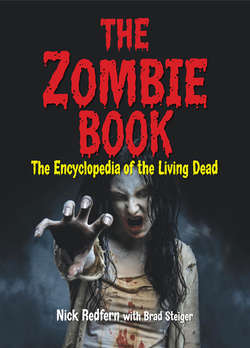Читать книгу The Zombie Book - Nick Redfern - Страница 35
Bowery at Midnight
ОглавлениеSome movies of the undead are very good. Others are extremely bad. Many are downright mediocre. Then there are those which are just plain weird. One of those that most definitely falls into the latter category is Bowery at Midnight, a movie whose name gives away absolutely nothing at all about its odd plotline. Despite the fact that the production, made in 1942, starred Hollywood horror legend and crowd puller Bela Lugosi, it has long since vanished into much welcome obscurity.
To say that the story is a strange one is an understatement of mammoth proportions. Lugosi takes on no less than two roles: by day he is Professor Frederick Brenner, a noted expert in the field of psychology who is employed at the University of New York. By night, however, Brenner has not just a different trade but an entirely different name, too: that of Karl Wagner. Lugosi, in his Wagner guise, is presented to the viewer as a kindly character, one who helps the needy, the broke, the homeless, and the sick, by giving them much needed shelter and food. Wagner even has his nurse, Judy, dishing out medicine to help those that need it. It is, however, all a big sham. Behind the scenes, Wagner has major, controversial plans in store for the growing numbers of the needy.
The dark reality of the situation is that, unbeknownst to Judy, Wagner and another of his associates are using mind-altering drugs to render the dregs of society into zombified states, and near identical conditions to those undead of Haitian lore. Or are they actually Night of the Living Dead-style zombies, after all? Confusingly, we never really know the truth. Neither, it seems, do the writer, director, and producer, since the movie is hardly easy to follow, as it meanders along its curious way. Wagner then uses his gang of dead or alive controlled characters to go robbing here and there, after which they take their dutiful steps into the cellar of the building in which he, Wagner, works, and where they remain until the next job looms on the horizon.
Judy’s boyfriend, Richard, just happens to be a student of Professor Brenner and views him as something of an inspiration—in terms of his dedication to the realm of psychology. So, one night Richard decides to visit the professor and Judy, chiefly because he, Richard, hopes that speaking with Brenner at a personal and private level will help his grades at school. It does not. Instead, Brenner—in his Wagner guise—drugs unfortunate Richard, turning him, too, into a walking and thieving automaton of the night.
Judy finally realizes the gravity of the situation, however—particularly so when Richard first vanishes then transforms—and the police are soon on the scene. Richard miraculously (and, for the viewer, confusingly) comes out of his undead state, while Brenner/Wagner meets a gruesome end at the hands of his zombie slaves. He does so deep in an old cellar: shades of a certain, memorable scene in George A. Romero’s 1968 production of Night of the Living Dead when young Karyn Cooper, perhaps the definitive zombie child of all time, kills her parents, Harry and Helen, in the basement of the farmhouse in which they are hiding.
That, however, is where the Night of the Living Dead parallels end. Of Romero quality Bowery at Midnight is most definitely not. Arguably, it’s not of any quality, except mediocre.
